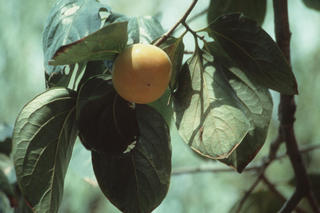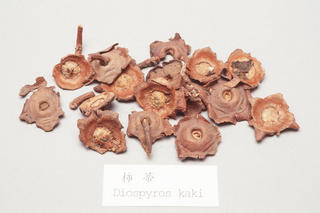Diospyros kaki
Contents
- 1 Nomenclature
- 2 Historical Use of Diospyros kaki
- 3 Background
- 4 Nomenclature
- 5 Historical Use of Diospyros kaki
- 6 Background
- 7 Nomenclature
- 8 Historical Use of Diospyros kaki
- 9 Background
- 10 Nomenclature
- 11 Historical Use of Diospyros kaki
- 12 Background
- 13 Nomenclature
- 14 Historical Use of Diospyros kaki
- 15 Background
- 16 Pharmaceutical Information
- 17 Evidence or the Use of Diospyros kaki in the Treatment of Epilepesy
- 18 Safety
Nomenclature
Other Names:
Historical Use of Diospyros kaki
Diospyros kaki in Traditional Chinese Medicine
Background
Chinese Name (pinyin): Shidi
Chinese Name :
Common Name :Kaki Calyx
Specific Name : Calyx Kaki
Scientific Name:
Collection : The drug is collected in winter when the fruit is ripe, wash clean and dried in the sun
Description : Oblate, 1.5-2.5cm in diameter, relatiely thick in the middle, slightly prominent with a rounded scar of fruit fallen off and somewhat thin at the edge, 4-lobed, the lobes frequently reflexed, easily broken. A fruit stalk or a pitted scar fruit stalk remained at the base. Outer surface yellowish-brown or reddish-brown, inner surface yellowish brown, densely covered with fine pubescences. Hard and fragile texture, odorless, taste astringent.
Identification : To 2g of the powder add 10ml of 70% ethanol, warmly macerate for 2 hours, filter, evaporate the filtrate to dryness, dissolve the residue in 1ml of methanol and use as the test solution. Dissolve Gallic acid CRS in methanol to produce a solution containing 0.5mg per ml as the reference solution. Carry out the method for thin layer chromatography (Appendix Vl B), using silica gel G containing sodium carboxymethylcellulose as the coating substance and toluence (saturated with water) methyl for- mate-formic acid (5:4:1) as the mobile phase. Apply separately 5µl of test solution and 2µl of the reference solution to the plate. After developing and removal of the plate, dry it in the air, spray with 1% solution of ferric chloride in ethanol. A spot in the chromatogram obtained with the test solution corresponds in the color and position to the spot in the chromatogram obtained with the reference solution.
Processing : eliminate foreign matter, wash clean, remove the stalk, dry and brak to pieces.
Action : To check the upward flow of the stomach qi.
Indication : hiccup
Precautions :
Dosage : 4.5 to 9 g.
Storage : Preserve in a ventilated and dry place, protected from moth.
Nomenclature
Other Names:
Historical Use of Diospyros kaki
Diospyros kaki in Traditional Chinese Medicine
Background
Chinese Name (pinyin): Shidi
Chinese Name :
Common Name :Kaki Calyx
Specific Name : Calyx Kaki
Scientific Name:
Collection : The drug is collected in winter when the fruit is ripe, wash clean and dried in the sun
Description : Oblate, 1.5-2.5cm in diameter, relatiely thick in the middle, slightly prominent with a rounded scar of fruit fallen off and somewhat thin at the edge, 4-lobed, the lobes frequently reflexed, easily broken. A fruit stalk or a pitted scar fruit stalk remained at the base. Outer surface yellowish-brown or reddish-brown, inner surface yellowish brown, densely covered with fine pubescences. Hard and fragile texture, odorless, taste astringent.
Identification : To 2g of the powder add 10ml of 70% ethanol, warmly macerate for 2 hours, filter, evaporate the filtrate to dryness, dissolve the residue in 1ml of methanol and use as the test solution. Dissolve Gallic acid CRS in methanol to produce a solution containing 0.5mg per ml as the reference solution. Carry out the method for thin layer chromatography (Appendix Vl B), using silica gel G containing sodium carboxymethylcellulose as the coating substance and toluence (saturated with water) methyl for- mate-formic acid (5:4:1) as the mobile phase. Apply separately 5µl of test solution and 2µl of the reference solution to the plate. After developing and removal of the plate, dry it in the air, spray with 1% solution of ferric chloride in ethanol. A spot in the chromatogram obtained with the test solution corresponds in the color and position to the spot in the chromatogram obtained with the reference solution.
Processing : eliminate foreign matter, wash clean, remove the stalk, dry and brak to pieces.
Action : To check the upward flow of the stomach qi.
Indication : hiccup
Precautions :
Dosage : 4.5 to 9 g.
Storage : Preserve in a ventilated and dry place, protected from moth.
Nomenclature
Other Names:
Historical Use of Diospyros kaki
Diospyros kaki in Traditional Chinese Medicine
Background
Chinese Name (pinyin): Shidi
Chinese Name :
Common Name :Kaki Calyx
Specific Name : Calyx Kaki
Scientific Name:
Collection : The drug is collected in winter when the fruit is ripe, wash clean and dried in the sun
Description : Oblate, 1.5-2.5cm in diameter, relatiely thick in the middle, slightly prominent with a rounded scar of fruit fallen off and somewhat thin at the edge, 4-lobed, the lobes frequently reflexed, easily broken. A fruit stalk or a pitted scar fruit stalk remained at the base. Outer surface yellowish-brown or reddish-brown, inner surface yellowish brown, densely covered with fine pubescences. Hard and fragile texture, odorless, taste astringent.
Identification : To 2g of the powder add 10ml of 70% ethanol, warmly macerate for 2 hours, filter, evaporate the filtrate to dryness, dissolve the residue in 1ml of methanol and use as the test solution. Dissolve Gallic acid CRS in methanol to produce a solution containing 0.5mg per ml as the reference solution. Carry out the method for thin layer chromatography (Appendix Vl B), using silica gel G containing sodium carboxymethylcellulose as the coating substance and toluence (saturated with water) methyl for- mate-formic acid (5:4:1) as the mobile phase. Apply separately 5µl of test solution and 2µl of the reference solution to the plate. After developing and removal of the plate, dry it in the air, spray with 1% solution of ferric chloride in ethanol. A spot in the chromatogram obtained with the test solution corresponds in the color and position to the spot in the chromatogram obtained with the reference solution.
Processing : eliminate foreign matter, wash clean, remove the stalk, dry and brak to pieces.
Action : To check the upward flow of the stomach qi.
Indication : hiccup
Precautions :
Dosage : 4.5 to 9 g.
Storage : Preserve in a ventilated and dry place, protected from moth.
Nomenclature
Other Names:
Historical Use of Diospyros kaki
Diospyros kaki in Traditional Chinese Medicine
Background
Chinese Name (pinyin): Shidi
Chinese Name :
Common Name :Kaki Calyx
Specific Name : Calyx Kaki
Scientific Name:
Collection : The drug is collected in winter when the fruit is ripe, wash clean and dried in the sun
Description : Oblate, 1.5-2.5cm in diameter, relatiely thick in the middle, slightly prominent with a rounded scar of fruit fallen off and somewhat thin at the edge, 4-lobed, the lobes frequently reflexed, easily broken. A fruit stalk or a pitted scar fruit stalk remained at the base. Outer surface yellowish-brown or reddish-brown, inner surface yellowish brown, densely covered with fine pubescences. Hard and fragile texture, odorless, taste astringent.
Identification : To 2g of the powder add 10ml of 70% ethanol, warmly macerate for 2 hours, filter, evaporate the filtrate to dryness, dissolve the residue in 1ml of methanol and use as the test solution. Dissolve Gallic acid CRS in methanol to produce a solution containing 0.5mg per ml as the reference solution. Carry out the method for thin layer chromatography (Appendix Vl B), using silica gel G containing sodium carboxymethylcellulose as the coating substance and toluence (saturated with water) methyl for- mate-formic acid (5:4:1) as the mobile phase. Apply separately 5µl of test solution and 2µl of the reference solution to the plate. After developing and removal of the plate, dry it in the air, spray with 1% solution of ferric chloride in ethanol. A spot in the chromatogram obtained with the test solution corresponds in the color and position to the spot in the chromatogram obtained with the reference solution.
Processing : eliminate foreign matter, wash clean, remove the stalk, dry and brak to pieces.
Action : To check the upward flow of the stomach qi.
Indication : hiccup
Precautions :
Dosage : 4.5 to 9 g.
Storage : Preserve in a ventilated and dry place, protected from moth.
Nomenclature
Other Names:
Historical Use of Diospyros kaki
Diospyros kaki in Traditional Chinese Medicine
Background
Chinese Name (pinyin): Shidi
Chinese Name :
Common Name :Kaki Calyx
Specific Name : Calyx Kaki
Scientific Name:
Collection : The drug is collected in winter when the fruit is ripe, wash clean and dried in the sun
Description : Oblate, 1.5-2.5cm in diameter, relatiely thick in the middle, slightly prominent with a rounded scar of fruit fallen off and somewhat thin at the edge, 4-lobed, the lobes frequently reflexed, easily broken. A fruit stalk or a pitted scar fruit stalk remained at the base. Outer surface yellowish-brown or reddish-brown, inner surface yellowish brown, densely covered with fine pubescences. Hard and fragile texture, odorless, taste astringent.
Identification : To 2g of the powder add 10ml of 70% ethanol, warmly macerate for 2 hours, filter, evaporate the filtrate to dryness, dissolve the residue in 1ml of methanol and use as the test solution. Dissolve Gallic acid CRS in methanol to produce a solution containing 0.5mg per ml as the reference solution. Carry out the method for thin layer chromatography (Appendix Vl B), using silica gel G containing sodium carboxymethylcellulose as the coating substance and toluence (saturated with water) methyl for- mate-formic acid (5:4:1) as the mobile phase. Apply separately 5µl of test solution and 2µl of the reference solution to the plate. After developing and removal of the plate, dry it in the air, spray with 1% solution of ferric chloride in ethanol. A spot in the chromatogram obtained with the test solution corresponds in the color and position to the spot in the chromatogram obtained with the reference solution.
Processing : eliminate foreign matter, wash clean, remove the stalk, dry and brak to pieces.
Action : To check the upward flow of the stomach qi.
Indication : hiccup
Precautions :
Dosage : 4.5 to 9 g.
Storage : Preserve in a ventilated and dry place, protected from moth.
Synonymns for Diospyros kaki
Patent Medicines and Medicines with Multiple Ingredients that include Diospyros kaki
Pharmaceutical Information
Chemical Constituents
Evidence or the Use of Diospyros kaki in the Treatment of Epilepesy
Basic Science
Animal Studies
Cohort, Case-Control and Non-Randomized Trials
Randomized Controlled Trials
Meta-Analysis
1st Five Results: pubmed search
EFSA Panel on Plant Health (PLH), Claude Bragard, Paula Baptista, Elisavet Chatzivassiliou, Francesco Di Serio, Paolo Gonthier, Josep Anton Jaques Miret, Annemarie Fejer Justesen, Christer Sven Magnusson, Panagiotis Milonas, Juan A Navas-Cortes, Stephen Parnell, Roel Potting, Philippe Lucien Reignault, Emilio Stefani, Hans-Hermann Thulke, Wopke Van der Werf, Antonio Vicent Civera, Jonathan Yuen, Lucia Zappalà, Jean-Claude Grégoire, Chris Malumphy, Spyridon Antonatos, Virag Kertesz, Dimitrios Papachristos, Oresteia Sfyra, Alan MacLeod
##Title##
EFSA J: 2024, 22(4);e8740
[PubMed:38650611]
[WorldCat.org]
[DOI]
(I e)
Jian Zhao, Zhongling Chen, Lingxi Li, Baoshan Sun
UHPLC-MS/MS analysis and protective effects on neurodegenerative diseases of phenolic compounds in different parts of Diospyros kaki L. cv. Mopan.
Food Res Int: 2024, 184;114251
[PubMed:38609229]
[WorldCat.org]
[DOI]
(I p)
Seiki Takatsuki, Masakazu Inaba
Food Habits of Raccoon Dogs at An Agricultural Area in Shikoku, Western Japan.
Zoolog Sci: 2024, 41(2);185-191
[PubMed:38587913]
[WorldCat.org]
[DOI]
(I p)
Endang Rahmat, Jae Sik Yu, Bum Soo Lee, Jiyoung Lee, Yeongjun Ban, Nam-Hui Yim, Jeong Hwan Park, Chang Ho Kang, Ki Hyun Kim, Youngmin Kang
##Title##
Heliyon: 2024, 10(7);e28464
[PubMed:38571591]
[WorldCat.org]
[DOI]
(P e)
Yasmim Cristina Rodrigues da Silva, Raysa Maduro Alves, Eliane Aparecida Benato, Franciane Colares Souza Usberti
Gaseous ozone and ozonized mist in the control of Escherichia coli on 'Rama Forte' persimmon.
Braz J Microbiol: 2024;
[PubMed:38561500]
[WorldCat.org]
[DOI]
(I a)

